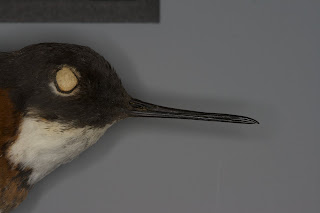![]()
Some birds can! A group of shorebirds called phalaropes have a curious way of feeding. They feed on the surface of lakes, tidal wetlands and other bodies of water by swimming around in a tight circle on the surface furiously kicking their legs. This creates a vortex in which tiny aquatic invertebrates like shrimp, aquatic insects and copepods are pulled to the surface. Once food items are trapped in the swirling water phalaropes gobble them up with their long thin bills. But, while the phalarope's curious means of concentrating aquatic invertebrates is well known less well understood is how they use their bills to consume their tiny water suspended prey. A team at the Massachusetts Institute of Technology lead by Manu Prakash has uncovered just how suspension feeding birds like phalaropes use their bills to draw up droplets of water packed with their invertebrate prey.
Unlike a straw a bird's bill is open on both sides and opens in an up-and-down motion much like a pair of tweezers so they can't suck up shrimp filled pond water like you would a slushie. In phalaropes their bills are long and very thin (see photo to the right of a Red-necked Phalarope (Phalaropus lobatus) from the Cincinnati Museum Center's Zoology collection). Just how phalaropes can use a tweezer-like bill in a straw-like fashion is a puzzle. Prakash and colleagues found that a drop of water in a very thin bill can be drawn up the bill by what they call a "capillary ratchet". They looked at data in the literature derived from real bills (much of which was originally from museum specimens) and built a mechanical bill with similar properties. When the bill is closed the drop of water is compressed and when opened again it moves a bit further up the bill towards the mouth. Close the bill again the water is compressed. Open again and it moves a bit further up the bill. Click HERE for a Quicktime movie of the Prakash et al. mechanical bill in action. The ability of an artificial bill to serve as a capillary ratchet is highly dependent on both it's shape and it's wetting properties.
like a pair of tweezers so they can't suck up shrimp filled pond water like you would a slushie. In phalaropes their bills are long and very thin (see photo to the right of a Red-necked Phalarope (Phalaropus lobatus) from the Cincinnati Museum Center's Zoology collection). Just how phalaropes can use a tweezer-like bill in a straw-like fashion is a puzzle. Prakash and colleagues found that a drop of water in a very thin bill can be drawn up the bill by what they call a "capillary ratchet". They looked at data in the literature derived from real bills (much of which was originally from museum specimens) and built a mechanical bill with similar properties. When the bill is closed the drop of water is compressed and when opened again it moves a bit further up the bill towards the mouth. Close the bill again the water is compressed. Open again and it moves a bit further up the bill. Click HERE for a Quicktime movie of the Prakash et al. mechanical bill in action. The ability of an artificial bill to serve as a capillary ratchet is highly dependent on both it's shape and it's wetting properties.
This study has several important implications. First, it describes a novel evolutionary adaptation in birds and helps us better understand the myriad of solutions that evolutionary processes can generate to basic challenges in life. Second, an understanding of biomechanics for natural structures like the bill of the phalarope can help human engineers design devices for moving very small amounts of liquid (i.e. microfluidic transport systems). Such devices, inspired by nature, can have important implications in nanotechnology and molecular biology and could potentially advance human health. Finally, because Prakash et al. found that the wetting properties of the bill were critical in its ability to act as a capillary ratchet device environmental managers should look for effects of pollutants on the feeding efficiency of phalaropes and other shorebird species. Petroleum products and detergents could have significant effects on the wetting properties of a phalarope bill and in turn lead to less food for affected birds.
Of course museums, like Cincinnati Museum Center, often play a significant role in these biomechanical studies by serving as storehouses of all the clever tricks invented by evolutionary processes. Taping into nature's diversity is not only good simply for the sake of a greater knowledge of our living world but it also can provide us with designs for our own technology, designs that have been tested over eons of evolutionary tinkering.
Prakash, M., Quere, D., Bush, J.W. (2008). Surface Tension Transport of Prey by Feeding Shorebirds: The Capillary Ratchet. Science, 320(5878), 931-934. DOI: 10.1126/science.1156023
-END